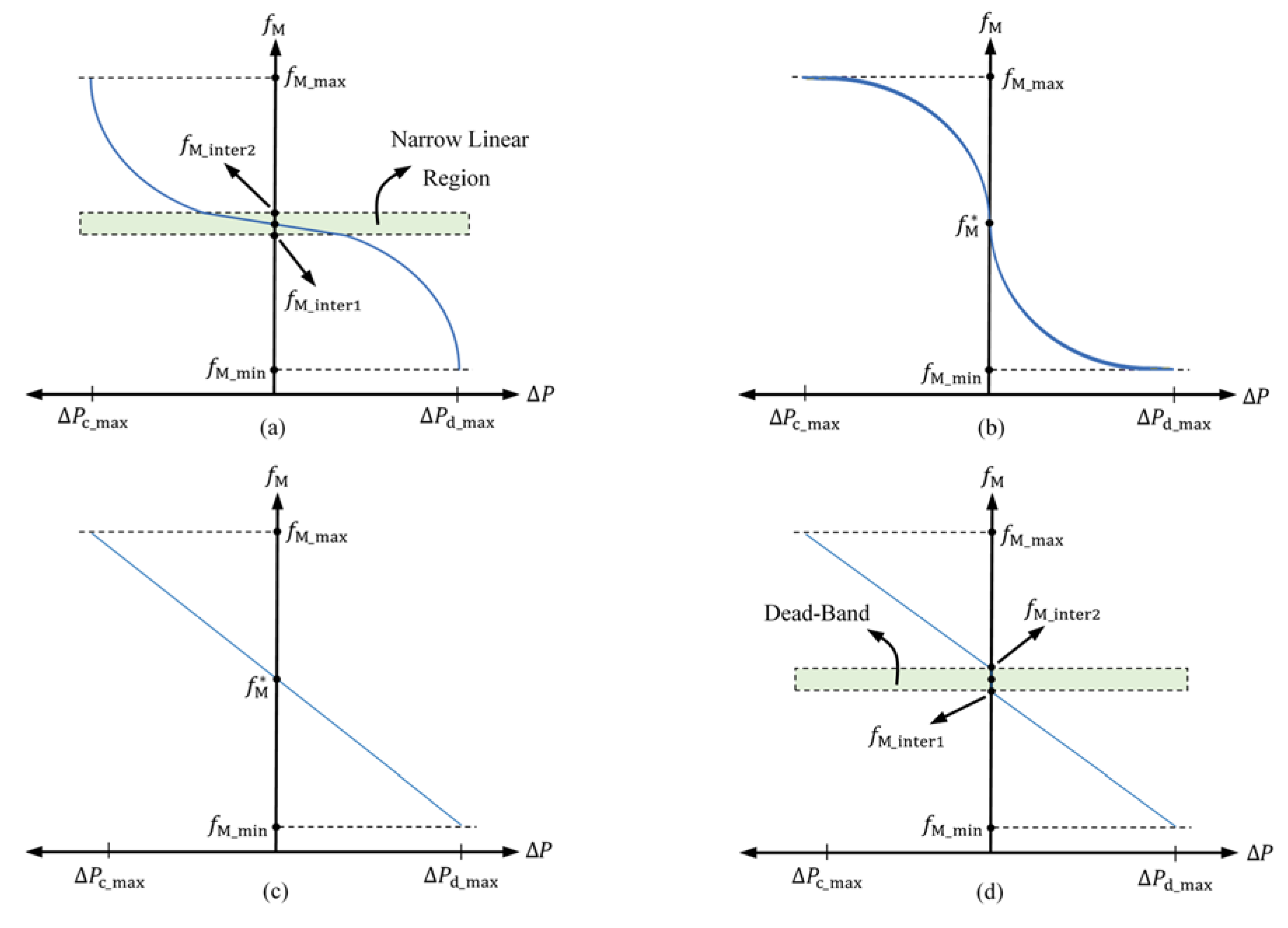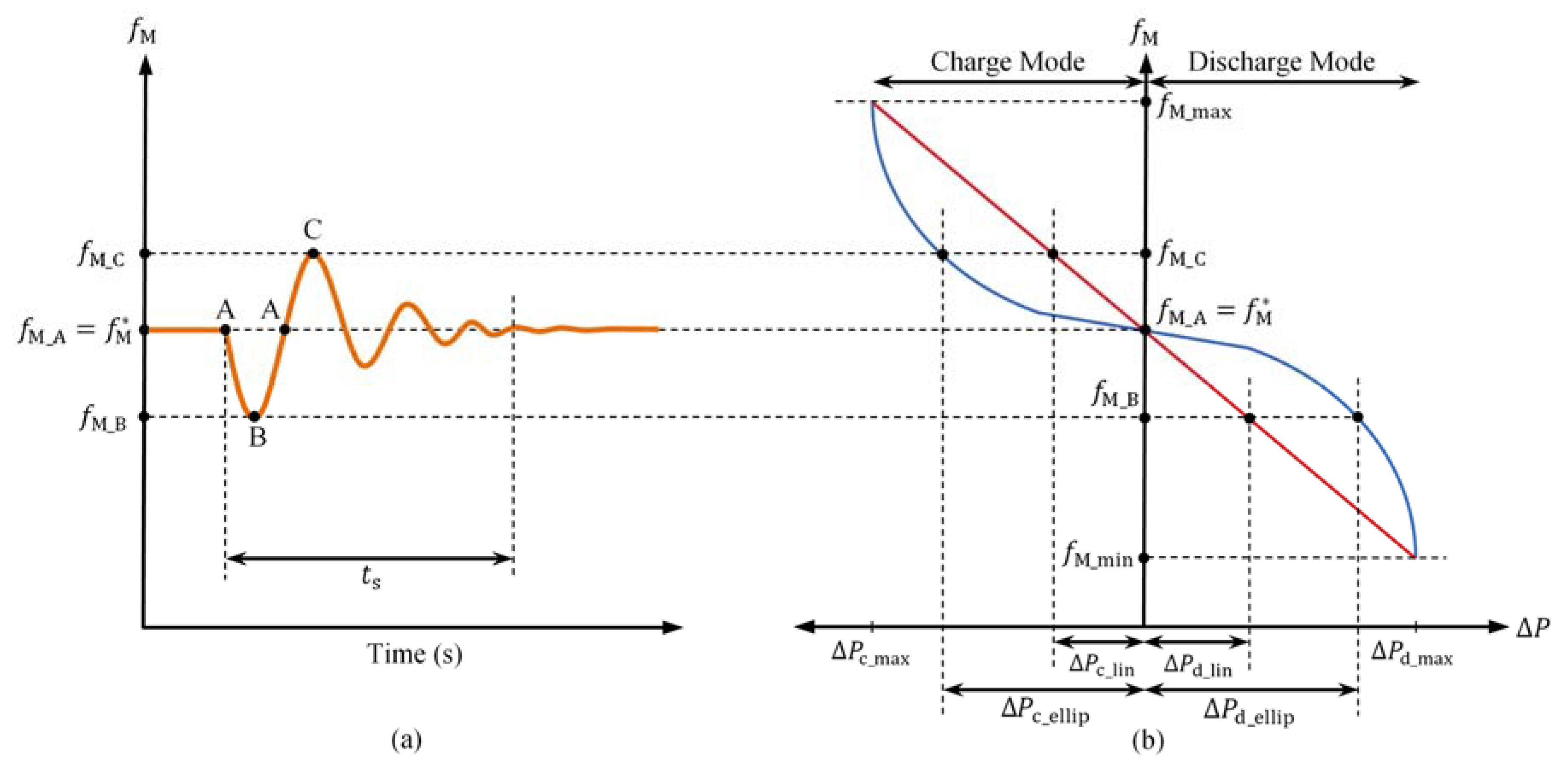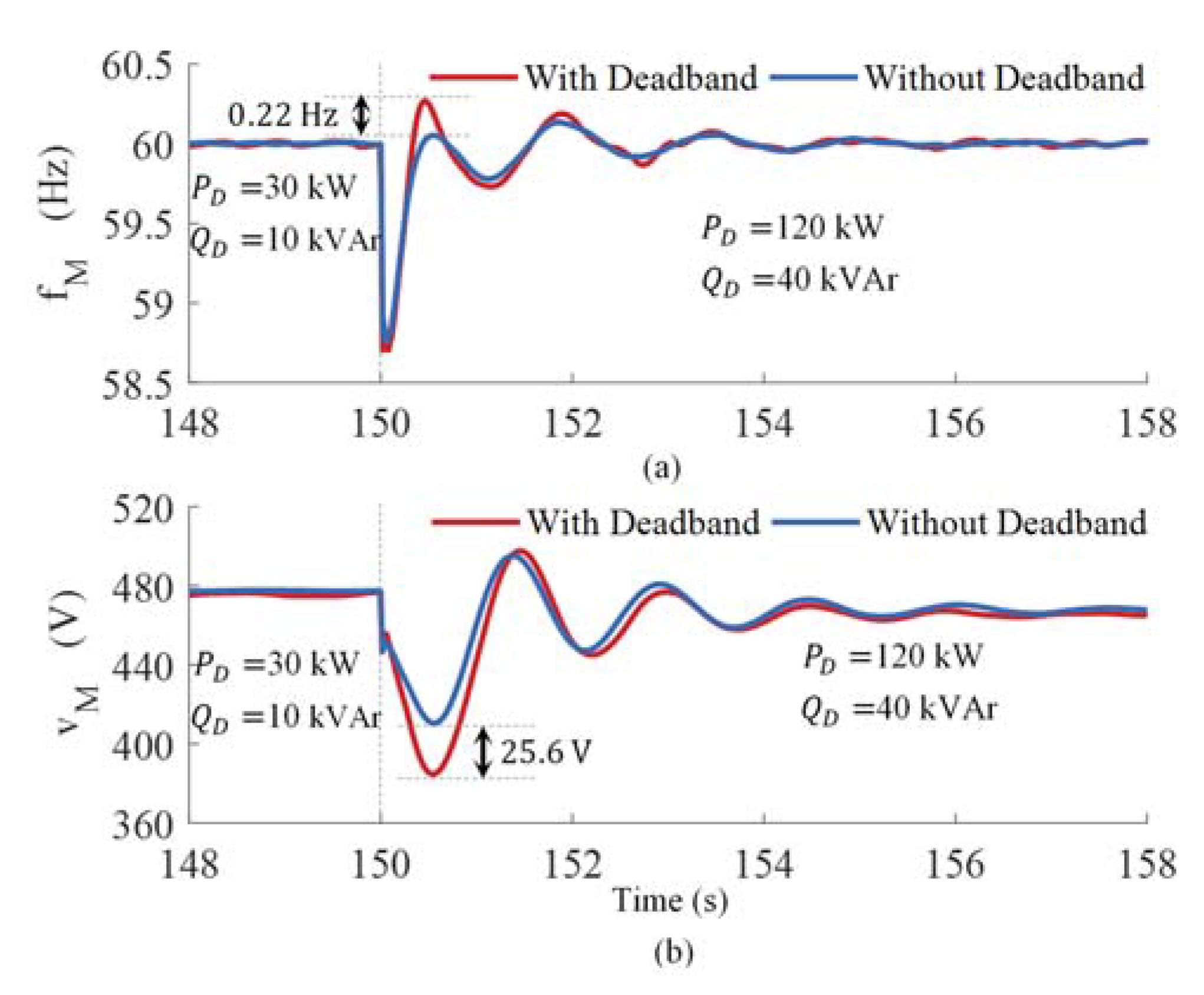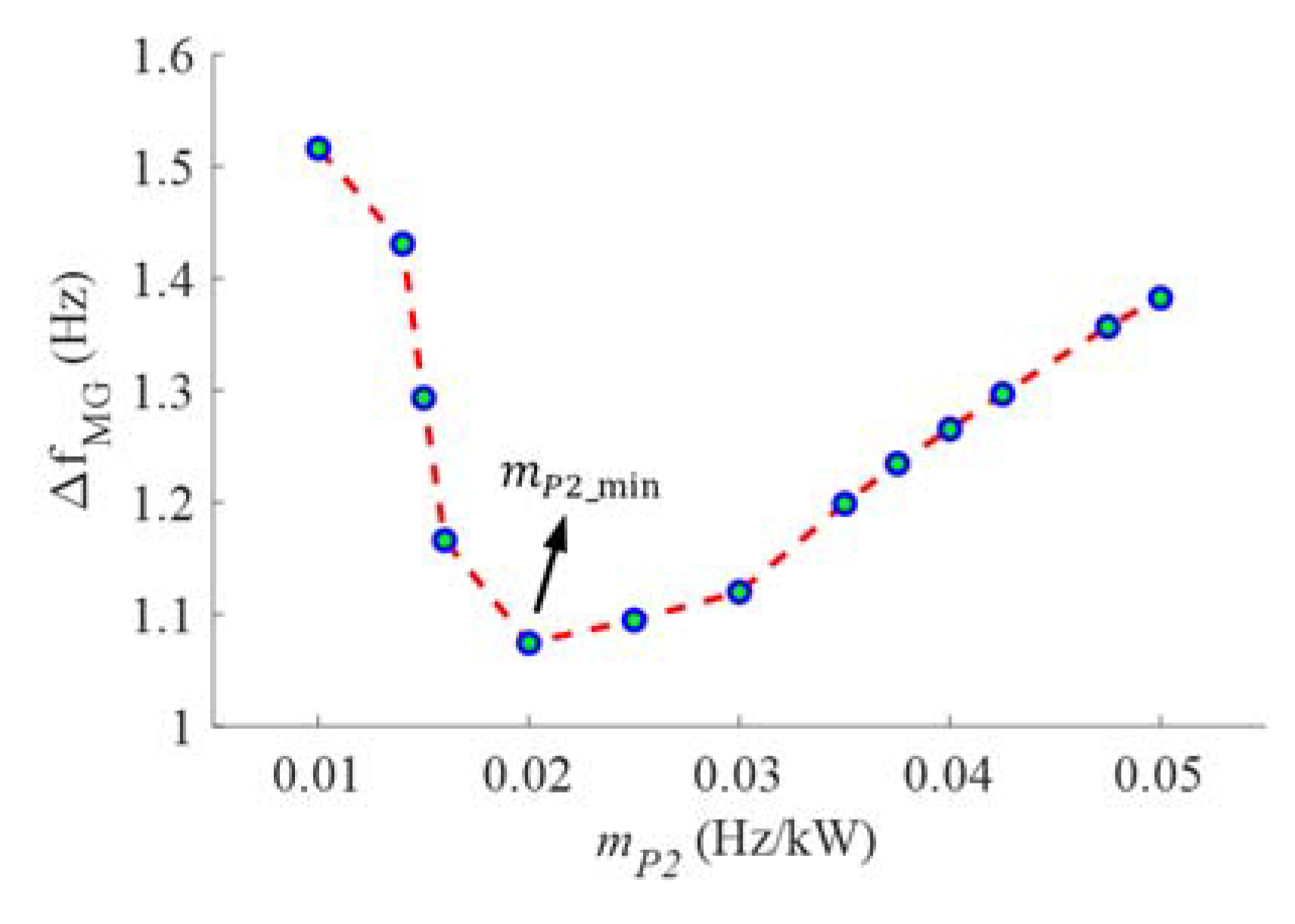Frequency and Voltage Supports by Battery-Fed Smart Inverters in Mixed-Inertia Microgrids
Abstract
:1. Introduction
2. System Description
3. Frequency Dynamic-Response Improvement
3.1. Frequency Dynamic-Response of the System
3.2. PLE P-f Droop
4. Voltage Dynamic-Response Improvement
5. Results and Discussion
5.1. Linear Droop with and without Dead Band
5.2. PLE Droop versus Linear Droop for Load Step Change
5.3. PLE Droop versus Linear Droop for the Transition from Grid-Connected to Islanded Mode
5.4. Change in the Length of Narrow Linear Regions
6. Conclusions
Author Contributions
Funding
Conflicts of Interest
References
- Adib, A.; Mirafzal, B.; Wang, X.; Blaabjerg, F. On stability of voltage source inverters in weak grids. IEEE Access 2018, 6, 4427–4439. [Google Scholar] [CrossRef]
- Ashabani, M.; Mohamed, Y.A.I. Integrating VSCs to weak grids by nonlinear power damping controller with self-synchronization capability. IEEE Trans. Power Syst. 2014, 29, 805–814. [Google Scholar] [CrossRef]
- Adib, A.; Mirafzal, B. Virtual inductance for stable operation of grid-interactive voltage source inverters. IEEE Trans. Ind. Electron. 2019, 66, 6002–6011. [Google Scholar] [CrossRef]
- Sachs, J.; Sawodny, O. A two-stage model predictive control strategy for economic diesel-PV-battery island microgrid operation in rural areas. IEEE Trans. Sustain. Energy 2016, 7, 903–913. [Google Scholar] [CrossRef]
- Singh, B.; Pathak, G.; Panigrahi, B.K. Seamless transfer of renewable-based microgrid between utility grid and diesel generator. IEEE Trans. Power Electron. 2018, 33, 8427–8437. [Google Scholar] [CrossRef]
- Hong, Y.-Y.; Lian, R.-C. Optimal sizing of hybrid wind/PV/diesel generation in a stand-alone power system using Markov-based genetic algorithm. IEEE Trans. Power Deliv. 2012, 27, 640–647. [Google Scholar] [CrossRef]
- Aderibole, A.; Zeineldin, H.H.; El-Moursi, M.S.; Peng, J.C.-H.; Al Hosani, M. Domain of stability characterization for hybrid microgrids considering different power sharing conditions. IEEE Trans. Energy Convers. 2018, 33, 312–323. [Google Scholar] [CrossRef]
- Engleitner, R.; Nied, A.; Cavalca, M.S.M.; da Costa, J.P. Dynamic analysis of small wind turbines frequency support capability in a low-power wind-diesel microgrid. IEEE Trans. Ind. Appl. 2018, 54, 102–111. [Google Scholar] [CrossRef]
- Fu, Q.; Montoya, L.F.; Solanki, A.; Nasiri, A.; Bhavaraju, V.; Abdallah, T.; Yu, D.C. Microgrid generation capacity design with renewables and energy storage addressing power quality and surety. IEEE Trans. Smart Grid 2012, 3, 2019–2027. [Google Scholar] [CrossRef]
- Dag, O.; Mirafzal, B. On stability of islanded low-inertia microgrids. In Proceedings of the 2016 Clemson University Power Systems Conference (PSC), Clemson, SC, USA, 8–11 March 2016; pp. 1–7. [Google Scholar]
- Miao, Z.; Domijan, A.; Fan, L. Investigation of microgrids with both inverter interfaced and direct AC-connected distributed energy resources. IEEE Trans. Power Deliv. 2011, 26, 1634–1642. [Google Scholar] [CrossRef]
- Vita, V.; Alimardan, T.; Ekonomou, L. The impact of distributed generation in the distribution networks’ voltage profile and energy losses. In Proceedings of the 2015 IEEE European Modelling Symposium (EMS), Madrid, Spain, 6–8 October 2015; pp. 260–265. [Google Scholar]
- Mirafzal, B.; Adib, A. On grid-interactive smart inverters: Features and advancements. IEEE Access 2020, 8, 160526–160536. [Google Scholar] [CrossRef]
- Adib, A.; Lamb, J.; Mirafzal, B. Ancillary services via VSIs in microgrids with maximum DC-bus voltage utilization. IEEE Trans. Ind. Appl. 2019, 55, 648–658. [Google Scholar] [CrossRef]
- Adib, A.; Lamb, J.; Mirafzal, B. Atypical PWM for maximizing 2L-VSI DC-bus utilization in inverter-based microgrids with ancillary services. In Proceedings of the 2018 IEEE Applied Power Electronics Conference and Exposition (APEC), San Antonio, TX, USA, 4–8 March 2018; pp. 2343–2348. [Google Scholar]
- Torkzadeh, R.; Eliassi, M.; Mazidi, P.; Rodriguez, P.; Brnobić, D.; Krommydas, K.F.; Stratigakos, A.C.; Dikeakos, C.; Michael, M.; Tapakis, R.; et al. Synchrophasor based monitoring system for grid interactive energy storage system control. In The International Symposium on High Voltage Engineering; Springer: Berlin/Heidelberg, Germany, 2019; pp. 95–106. [Google Scholar]
- Guan, Y.; Vasquez, J.C.; Guerrero, J.M.; Wang, Y.; Feng, W. Frequency stability of hierarchically controlled hybrid photovoltaic-battery-hydropower microgrids. IEEE Trans. Ind. Appl. 2015, 51, 4729–4742. [Google Scholar] [CrossRef]
- Mondal, A.; Illindala, M.S. Improved frequency regulation in an islanded mixed source microgrid through coordinated operation of DERs and smart loads. IEEE Trans. Ind. Appl. 2018, 54, 112–120. [Google Scholar] [CrossRef]
- Sun, C.; Joos, G.; Bouffard, F. Adaptive coordination for power and SoC limiting control of energy storage in islanded AC microgrid with impact load. IEEE Trans. Power Deliv. 2019, 35, 580–591. [Google Scholar] [CrossRef]
- Tran, Q.T.T.; di Silvestre, M.L.; Sanseverino, E.R.; Zizzo, G.; Pham, T.N. Driven primary regulation for minimum power losses operation in islanded microgrids. Energies 2018, 11, 2890. [Google Scholar] [CrossRef] [Green Version]
- Mercier, P.; Cherkaoui, R.; Oudalov, A. Optimizing a battery energy storage system for frequency control application in an isolated power system. IEEE Trans. Power Syst. 2009, 24, 1469–1477. [Google Scholar] [CrossRef]
- Frack, P.F.; Mercado, P.E.; Molina, M.G.; Watanabe, E.H.; de Doncker, R.W.; Stagge, H. Control strategy for frequency control in autonomous microgrids. IEEE J. Emerg. Sel. Top. Eelectron. 2015, 3, 1046–1055. [Google Scholar] [CrossRef]
- Eliassi, M.; Torkzadeh, R.; Mazidi, P.; Rodriguez, P.; Pastor, R.; Vita, V.; Zafiropoulos, E.; Dikeakos, C.; Michael, M.; Tapakis, R.; et al. Conflict of Interests Between SPC-Based BESS and UFLS Scheme Frequency Responses. In The International Symposium on High Voltage Engineering; Springer: Berlin/Heidelberg, Germany, 2019; pp. 61–72. [Google Scholar]
- Pilehvar, M.S.; Mirafzal, B. A frequency control method for islanded microgrids using energy storage systems. In Proceedings of the 2020 IEEE Applied Power Electronics Conference and Exposition (APEC), New Orleans, LA, USA, 15–19 March 2020; pp. 2327–2332. [Google Scholar]
- Datta, M.; Senjyu, T.; Yona, A.; Funabashi, T.; Kim, C.-H. A frequency-control approach by photovoltaic generator in a PV–diesel hybrid power system. IEEE Trans. Energy Convers. 2011, 26, 559–571. [Google Scholar] [CrossRef]
- Elmitwally, A.; Rashed, M. Flexible operation strategy for an isolated PV-diesel microgrid without energy storage. IEEE Trans. Energy Convers. 2011, 26, 235–244. [Google Scholar] [CrossRef]
- Farrokhabadi, M.; Cañizares, C.A.; Bhattacharya, K. Frequency control in isolated/islanded microgrids through voltage regulation. IEEE Trans. Smart Grid 2017, 8, 1185–1194. [Google Scholar] [CrossRef]
- Pilehvar, M.S.; Shadmand, M.B.; Mirafzal, B. Analysis of smart loads in nanogrids. IEEE Access 2019, 7, 548–562. [Google Scholar] [CrossRef]
- Pilehvar, M.S.; Shadmand, M.B.; Mirafzal, B. Smart loads for power quality and battery lifetime improvement in nanogrids. In Proceedings of the 2019 IEEE Applied Power Electronics Conference and Exposition (APEC), Anaheim, CA, USA, 17–21 March 2019; pp. 2029–2034. [Google Scholar]
- Alobeidli, K.A.; Syed, M.H.; el Moursi, M.S.; Zeineldin, H.H. Novel coordinated voltage control for hybrid micro-grid with islanding capability. IEEE Trans. Smart Grid 2015, 6, 1116–1127. [Google Scholar] [CrossRef] [Green Version]
- Esmaeilian, H.R.; Fadaeinedjad, R. A remedy for mitigating voltage fluctuations in small remote wind-diesel systems using network theory concepts. IEEE Trans. Smart Grid 2018, 9, 4162–4171. [Google Scholar] [CrossRef]
- Kim, J.Y.; Jeon, J.; Kim, S.-K.; Cho, C.; Park, J.H.; Kim, H.-M.; Nam, K.-Y. Cooperative control strategy of energy storage system and microsources for stabilizing the microgrid during islanded operation. IEEE Trans. Power Electron. 2010, 25, 3037–3048. [Google Scholar]
- Kim, Y.-S.; Kim, E.-S.; Moon, S.-I. Frequency and voltage control strategy of standalone microgrids with high penetration of intermittent renewable generation systems. IEEE Trans. Power Syst. 2016, 31, 718–728. [Google Scholar] [CrossRef]
- Ibrahim, H.M.; el Moursi, M.S.; Huang, P.-H. Adaptive roles of islanded microgrid components for voltage and frequency transient responses enhancement. IEEE Trans. Ind. Inform. 2015, 11, 1298–1312. [Google Scholar] [CrossRef]
- Soni, N.; Doolla, S.; Chandorkar, M.C. Improvement of transient response in microgrids using virtual inertia. IEEE Trans. Power Deliv. 2013, 28, 1830–1838. [Google Scholar] [CrossRef]
- Chen, F.; Burgos, R.; Boroyevich, D.; Vasquez, J.C.; Guerrero, J.M. Investigation of nonlinear droop control in DC power distribution systems: Load sharing, voltage regulation, efficiency, and stability. IEEE Trans. Power Electron. 2019, 34, 9404–9421. [Google Scholar] [CrossRef]
- Cingoz, F.; Elrayyah, A.; Sozer, Y. Plug-and-play nonlinear droop construction scheme to optimize islanded microgrid operations. IEEE Trans. Power Electron. 2016, 32, 2743–2756. [Google Scholar] [CrossRef]










| Parameter | Value | |
|---|---|---|
| Distributed Generation (DG) Units | Battery operating voltage range | 360–600 V |
| Battery rated energy | 101 kWh | |
| PV maximum power | 50 kW | |
| Diesel generator maximum power | 127 kW | |
| Diesel generator inertia constant (H) | 0.3 s | |
| Linear and PLE Droops | 60 Hz | |
| 58 Hz | ||
| 62 Hz | ||
| (line-to-line) | 480 V | |
| (line-to-line) | 400 V | |
| (line-to-line) | 560 V | |
| 0.05 Hz/kW | ||
| 0.02 Hz/kW | ||
| 13 V/kVAr | ||
| 4 V/kVAr |
| With Linear | With PLE | |||
|---|---|---|---|---|
| Settling Time | Over Shoot | Settling Time | Over Shoot | |
| 3 s | 0.1371 Hz | 2 s | 0.0472 Hz | |
| 4 s | 30 V | 2.5 s | 10 V | |
| 4 s | 17 kW | 3 s | 9 kW | |
| 4 s | 5 kVAr | 3 s | 2 kVAr | |
| With Linear | With PLE | |||
|---|---|---|---|---|
| Settling Time | Over Shoot | Settling Time | Over Shoot | |
| 7 s | 1.1 Hz | 3 s | 0.8 Hz | |
| 9 s | 70 V | 5 s | 53 V | |
| 8 s | 15 kW | 4 s | 10 kW | |
| 9 s | 6 kVAr | 4 s | 4 kVAr | |
Publisher’s Note: MDPI stays neutral with regard to jurisdictional claims in published maps and institutional affiliations. |
© 2020 by the authors. Licensee MDPI, Basel, Switzerland. This article is an open access article distributed under the terms and conditions of the Creative Commons Attribution (CC BY) license (http://creativecommons.org/licenses/by/4.0/).
Share and Cite
S. Pilehvar, M.; Mirafzal, B. Frequency and Voltage Supports by Battery-Fed Smart Inverters in Mixed-Inertia Microgrids. Electronics 2020, 9, 1755. https://doi.org/10.3390/electronics9111755
S. Pilehvar M, Mirafzal B. Frequency and Voltage Supports by Battery-Fed Smart Inverters in Mixed-Inertia Microgrids. Electronics. 2020; 9(11):1755. https://doi.org/10.3390/electronics9111755
Chicago/Turabian StyleS. Pilehvar, Mohsen, and Behrooz Mirafzal. 2020. "Frequency and Voltage Supports by Battery-Fed Smart Inverters in Mixed-Inertia Microgrids" Electronics 9, no. 11: 1755. https://doi.org/10.3390/electronics9111755





